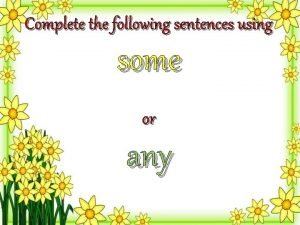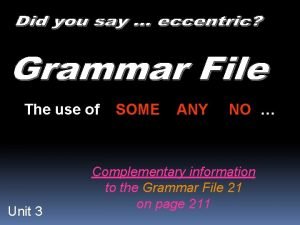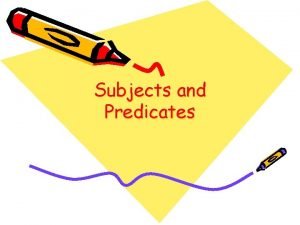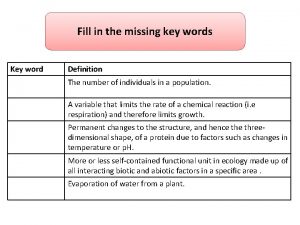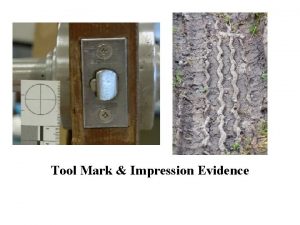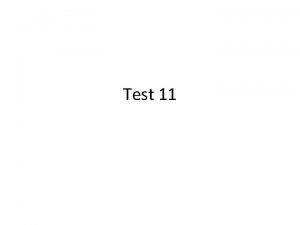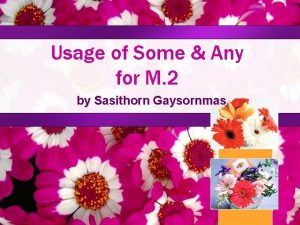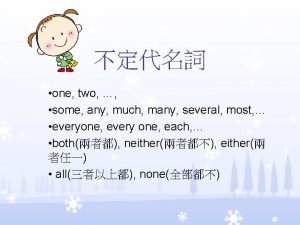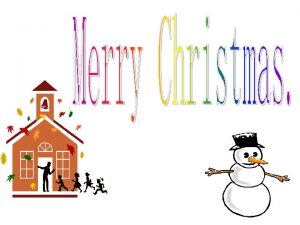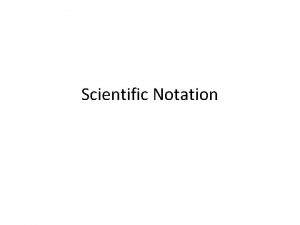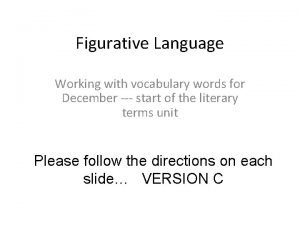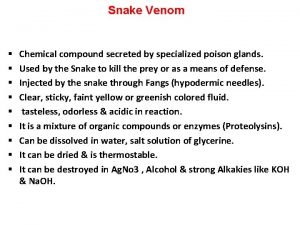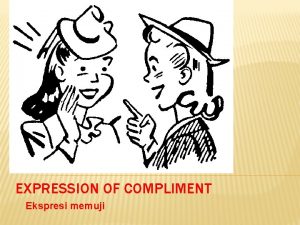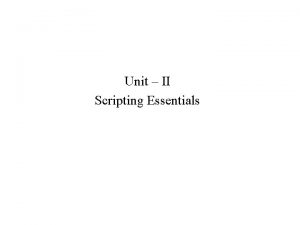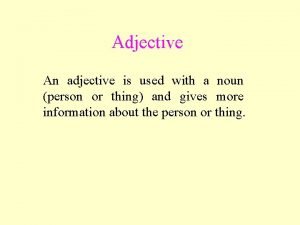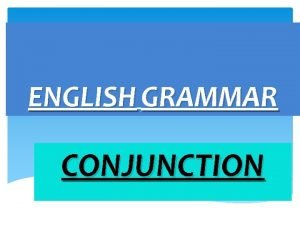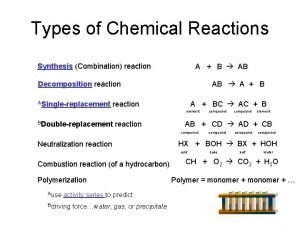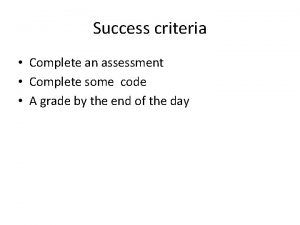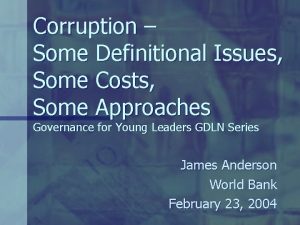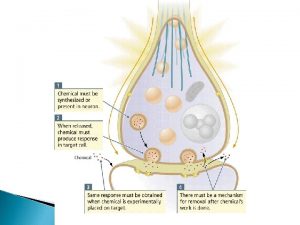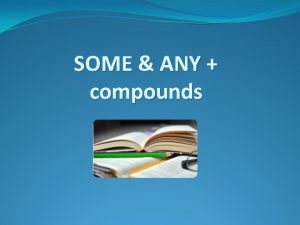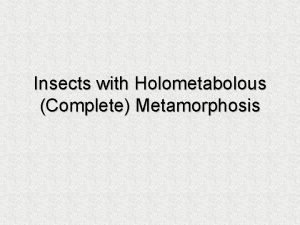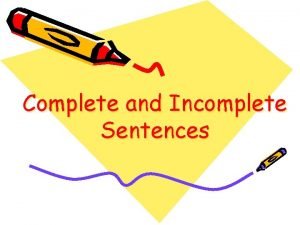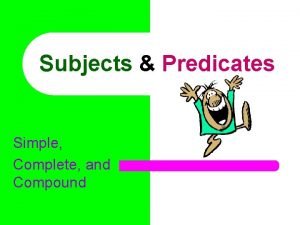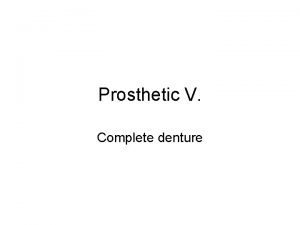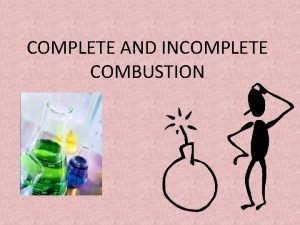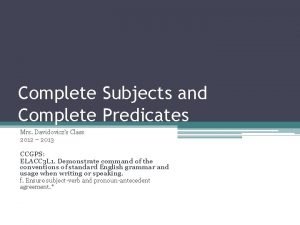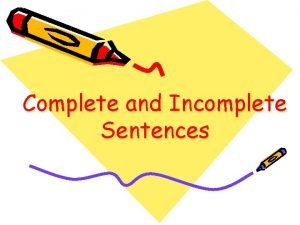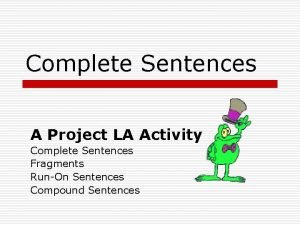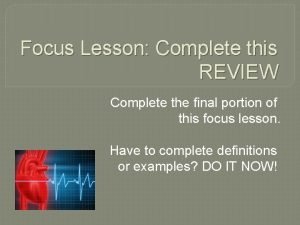LO To complete some SC 1 I will















![Can you explain these quotes? “changed me like a glove” ”“bound you” “[have] a Can you explain these quotes? “changed me like a glove” ”“bound you” “[have] a](https://slidetodoc.com/presentation_image_h/d708723e022ac436be0764c9b245d231/image-16.jpg)











- Slides: 27

LO: To complete some SC: 1) I will be able to explain what the poem is about. 2) I can close analysis using the articulate what view the speaker has. 3) I can analyse some key poetic SPIRIT template. techniques. Christina Georgina Rossetti (5 December 1830 – 29 December 1894) was an English poet who wrote a variety of romantic, devotional, and children's poems. Many scholars have identified feminist themes in her poetry. She was opposed to slavery, cruelty to animals and the exploitation of girls in under-age prostitution

What the poem is about… The poem 'Cousin Kate' is about a young cottage maiden who falls pregnant by the 'Lord of the manor‘. She thought he loved her but he didn't and when he found out she was pregnant he 'changed [her] like a glove‘. Now he is marrying her cousin, (Kate) whom he ‘bound … with his ring. ' The tone of the poem is angry and anxious. The speaker is confused at the experience she has had to endure. Her emotions are strong and violent and her anger is expressed through her imagination.

Cousin Kate by Christina Rossetti Learning Objectives To understand how Rossetti has used narrative form and language to explore relationships and evoke sympathy in the reader.

Glossary • Cottage-maiden: a girl born and brought up in a rural cottage • Flaxen: pale yellow • Woe: sorrow or misfortune • Thereof: of this • Cast me by: throw off • Sport: playing • Rye: cereal used to make bread, biscuits, etc. • Mean estate: poor home/background • Sire: father • Coronet: crown

LO: To complete some SC: 1) I will be able to explain what the poem is about. 2) I can close analysis using the articulate what view the speaker has. 3) I can analyse some key poetic SPIRIT template. techniques. Cousin Kate “…you were so good and pure. ” Make annotations in SMALL writing on the poem: 1) What connotations does the word “good” have? (what does it make you think of? ) 2) And “pure”?

LO: To complete some SC: 1) I will be able to explain what the poem is about. 2) I can close analysis using the articulate what view the speaker has. 3) I can analyse some key poetic SPIRIT template. techniques. Poetic Devices 1) From what perspective is the poem told? What does this tell us about the power that the speaker has if she is nameless? Structure 4) What does the repetition of the question mark tell us about the narrator? Poetic Devices 2) “Cottage maiden” is juxtaposed with “great lord, ” why? I was a cottage maiden Hardened by sun and air Contented with my cottage mates, Not mindful I was fair. Why did a great lord find me out, And praise my flaxen hair? Why did a great lord find me out, To fill my heart with care? Imagery 3) Look at “contented” and “not mindful”. Is the language active or passive? What does this tell us about the power held by women in Victorian England?

LO: To complete some SC: 1) I will be able to explain what the poem is about. 2) I can close analysis using the articulate what view the speaker has. 3) I can analyse some key poetic SPIRIT template. techniques. Imagery Poetic Devices 1) What does the word “lured” tell us about the lord? 3) Why has the poet used the oxymoron “shameless shameful life” to describe the narrator? Imagery 2) Annotate the 2 similes in this stanza. What do they tell us about the lord? He lured me to his palace home - Woe's me for joy thereof- To lead a shameless shameful life, His plaything and his love. He wore me like a silken knot, He changed me like a glove; So now I moan, an unclean thing, Who might have been a dove. Imagery 4) What is “unclean thing” a reference to?

LO: To complete some SC: 1) I will be able to explain what the poem is about. 2) I can close analysis using the articulate what view the speaker has. 3) I can analyse some key poetic SPIRIT template. techniques. Imagery 4) This poem is full of contrasts – label two in this stanza and explain why the poet uses so many. Imagery 1)How would you describe the language in this stanza (and the rest of the poem)? Simple, complex? How many syllables do lots of the words contain? What effect is created by the language? O Lady Kate, my cousin Kate, You grew more fair than I: He saw you at your father's gate, Chose you, and cast me by. He watched your steps along the lane, Your work among the rye; He lifted you from mean estate To sit with him on high. Imagery 2) How do the underlined phrases make the lord sound? A B C B A B Rhyme 3) Label the rhyme scheme in this stanza. Is it regular or irregular in the poem? What effect does this create?

LO: To complete some SC: 1) I will be able to explain what the poem is about. 2) I can close analysis using the articulate what view the speaker has. 3) I can analyse some key poetic SPIRIT template. techniques. Poetic Devices 1) Why is the underlined phrase repeated? What does it highlight about the narrator’s feelings? Because you were so good and pure He bound you with his ring: The neighbors call you good and pure, Call me an outcast thing. Even so I sit and howl in dust, You sit in gold and sing: Now which of us has tenderer heart? You had the stronger wing Imagery 2) a) In contrast, what do “the neighbours” call the narrator? b) What connotations do these two words contain? c) What does this tell us about Victorian attitudes to love and marriage? Imagery 3) “howl in dust” is an example of vivid imagery; annotate the two words on your poem. We will discuss connotations afterwards. Ideas 4) What themes and ideas does Rossetti convey in this poem?

LO: To complete some SC: 1) I will be able to explain what the poem is about. 2) I can close analysis using the articulate what view the speaker has. 3) I can analyse some key poetic SPIRIT template. techniques. Tone / Voice 1) Who is the narrator addressing for much of the poem? How would O cousin Kate, my love was true, Your love was writ in sand: you describe her If he had fooled not me but you, tone of voice? If you stood where I stand, He'd not have won me with his love Nor bought me with his land; I would have spit into his face And not have taken his hand. NOTE: The lord in this poem is not reproached for the way he behaves, whilst the narrator is. Imagery 2) This is a vivid image. What does it tell you about the way the narrator feels? Poetic Devices 3) What tense is the underlined quotation written in? What does this tell you about the power available to women in Victorian society?

LO: To complete some SC: 1) I will be able to explain what the poem is about. 2) I can close analysis using the articulate what view the speaker has. 3) I can analyse some key poetic SPIRIT template. techniques. Imagery 1) What is “gift” a metaphor for? Tone / Voice 2) This stanza symbolises a shift in tone and mood for the narrator – how is this reflected in the line “I’ve little doubt you fret”? Yet I've a gift you have not got, And seem not like to get: For all your clothes and wedding-ring I've little doubt you fret. My fair-haired son, my shame, my pride, Cling closer, closer yet: Your father would give his lands for one To wear his coronet Poetic Devices 3) What does the alliteration tell us about the speaker?

Themes… • • LOVE MOTHERHOOD WEALTH EMPLOYMENT PROPERTY MARRIAGE SOCIAL STATUS

Tone • Tone: Tone is the attitude the poet (or narrative voice, in this case) takes towards his or her poem. A poem's tone shows the attitude towards characters, events, PLACES, etc. The tone of a poem can C H A N G E. Tone is not the same as mood or feeling. • Notice that the narrator never directly addresses the male. Why do you think this is? What does it infer about their relationship?

S 1 S 2 S 3 S 4 S 5 S 6 What happens in this stanza Tone and ‘quote’ The narrator describes her poor and care-free life and how a lord pursued her to be his. The tone is one of regret as she has changed from being ‘contented’ to filled ‘with care’.

Images and imagery • Given Rossetti’s use of imagery and images, this is a very visual poem. The similes in the poem work well in expressing the cottage maiden's emotions and help to create an angry and sad mood to the poem. Can you identify any examples of imagery (similes/metaphors) in the poem and explain their effect? Here are some examples for you… • The simile 'he wore me like a silken knot' links the treatment of the cottage maiden with treatment of discarded clothing. • The simile 'he changed me like a glove' shows how quickly and easily the Lord 'dumped' the Cottage maiden for her cousin.
![Can you explain these quotes changed me like a glove bound you have a Can you explain these quotes? “changed me like a glove” ”“bound you” “[have] a](https://slidetodoc.com/presentation_image_h/d708723e022ac436be0764c9b245d231/image-16.jpg)
Can you explain these quotes? “changed me like a glove” ”“bound you” “[have] a gift you have not got” “cast me by” “Chose you” “lured me” “saw you” “lifted you” “sit and howl in dust” “praise my flaxen hair” “find me out” “sit in gold and sing” “fill my heart with care” “wore me like a silken knot” “sit with him on high” ”watched your steps” “grew more fair” “moan, an unclean thing”

Contrast: A technique poets often use is that of contrast. This is where two (or more) things are compared and linked in order to show similarities and differences. This is a poem about relationships and the change between the three main characters: the cottage maiden, Cousin Kate and the lord. The reader is presented with a love triangle. It is a poem full of differences, with particular focus on the differences between both women, as the narrator questions and wonders whether this is the reason for her ‘casting away’. However, it is not only a poem with contrast between both women. Throughout the poem, Rossetti presents a variety of contrasting images.

Paired work • Work in pairs to make a list of the contrasts she presents in the poem. One example has been done for you. You should be able to find at least six examples. • • He contrasts the neighbours’ opinions of the narrator (“an outcast thing”) and their opinion of Cousin Kate (“good and pure”). (Worksheet on contrasting words (B 10. 3) - Edexcel

Two women arte described in the poem – the narrator and her cousin, Kate. Copy and complete the grid below, finding information about each girl and her behaviour. Make it clear whether it is a similarity or difference between the girls

The narrator She is described as ‘hardened by sun and air’ Cousin Kate She is described as: ‘You grow more fair than I’ Similarity Difference Cousin Kate is described as being more attractive than the narrator. The narrator is suggested as being perhaps older, or that exposure to the weather has slightly faded her beauty. The narrator has been treated badly by the lord, but her cousin has received marriage and great riches.

Looking closely at the poem • This poem was written in the 19 th century so it contains many words that are less common today. Look at the following words from the poem and see if you can work out their meaning: maiden, mindful, fair, flaxen, lured, palace-home, woe’s me, mean estate, outcast, howl in dust, gold, fret, sire, coronet • Find the words Rossetti uses that are connected with wealth. • Find the words Rossetti uses that are connected with pain and dirt.

The ending of the poem is interesting: My fair-haired son, my shame, my pride, Cling closer, closer yet: Your father would give his lands for one To wear his coronet. a) b) c) Pick out any words that suggest the woman is pleased that she has a son. Why would her feelings about having a son be mixed? Why would the ending of the poem be seen as a triumph for the narrator?

Language Rossetti uses many words connected to wealth and status. Identify them and say why you think this is? There also many words connected with pain and dirt. Identify them and say why you think this is.

Structure/Form • The poem is in the form of a ballad. Ballads were often spoken aloud as a form of storytelling and frequently relate to tragic events. They often have a particular rhyme scheme. • What do you notice about the structure of the poem? • Why do you think that Rossetti decided that the ballad form was the best for presenting her ideas? • What do the rhythm and rhyme add to the poem?


Area of analysis Structure Techniques within this area Layout, stanza shape, punctuation Poetic devices Repetition, personification, onomatopoeia, alliteration, assonance, any non-standard English Similes, metaphors, language choice. Imagery Rhythm/rhy me Ideas Tone/voice Rhyme scheme, rhythm, assonance, alliteration Themes and messages. The character of the persona (the person speaking in the poem, NOT the poet) Overall tone or mood and how this is

Grade How does Rossetti use contrasts and juxtaposition to express the narrator’s views? B/A C D E - Explain the significance of the poetic features and the effect it has on the reader. - Consider how the effect links to theme of the poem. - Consider historical/literary context and significance. - Consider alternative explanations. - Explain how the quotations link to theme you have identified. - Identify a poetic feature and how this supports your point. Find two quotations that support your observation. Describe the content of the poem and identify the key theme. Structure Poetic Devices Imagery Rhythm /Rhyme Ideas Tone
 Some trust in chariots and some in horses song
Some trust in chariots and some in horses song Contact and noncontact forces
Contact and noncontact forces They say sometimes you win some
They say sometimes you win some Fire and ice diamante poem
Fire and ice diamante poem They say it only takes a little faith to move a mountain
They say it only takes a little faith to move a mountain Some say the world will end in fire some say in ice
Some say the world will end in fire some say in ice Is ice cream countable or uncountable
Is ice cream countable or uncountable Complete the sentences using some or any
Complete the sentences using some or any Some any exercises
Some any exercises What are complete subjects
What are complete subjects Bacterial growth
Bacterial growth Grab some paper
Grab some paper Marks that are made when surfaces slide across one another.
Marks that are made when surfaces slide across one another. Some test keyword 12
Some test keyword 12 What is a logical view of data?
What is a logical view of data? There are some apples on the table
There are some apples on the table How many is several
How many is several Lesson 50
Lesson 50 Ctip clause that must be included in every contract
Ctip clause that must be included in every contract Child workers some as young as 10
Child workers some as young as 10 Advantages of scientific notation
Advantages of scientific notation Literary devices in shrek
Literary devices in shrek Some snakes are venomous complex sentence
Some snakes are venomous complex sentence Mention 5 expressions of compliment
Mention 5 expressions of compliment What are the types of scripting language
What are the types of scripting language Popular superlative
Popular superlative Coordinating conjunction examples
Coordinating conjunction examples What is combination reaction
What is combination reaction







